This post may contain affiliate links. For more information, please see our affiliate policy.
Homemade Smoked Salmon is a treat all on its own, on a bagel, in a dip, or as part of an appetizer board. My Smoked Salmon recipe is tender, smoky, and yes, absolutely worth it to DIY.
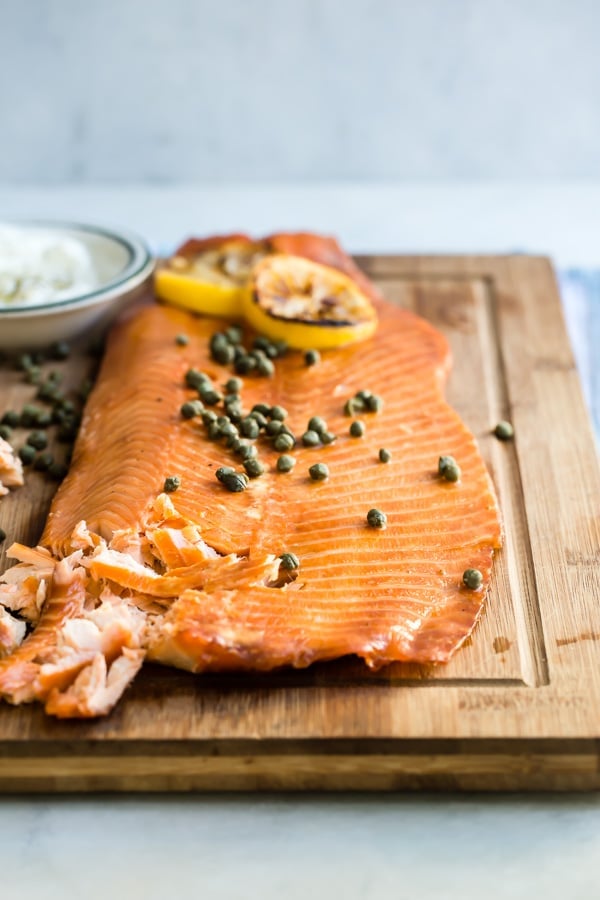
Discover how to make Smoked Salmon at home; yes, it’s possible! This guide for my ultimate homemade Smoked Salmon recipe takes you through how to make Smoked Salmon step by step; if you have a smoker, you’re already well on your way.
I recommend a hot-smoking process, but the smoking temperature is kept to a minimum for maximum velvety texture and flavor. Unlike cold-smoking, which puts the salmon through a lengthy curing and smoking process at a very low temperature, hot-smoking salmon can be smoked over the course of an afternoon, which is ideal; especially if you’re hungry (and even more so if you have a fresh batch of bagels that need a buddy!).
Table of Contents
Recipe ingredients
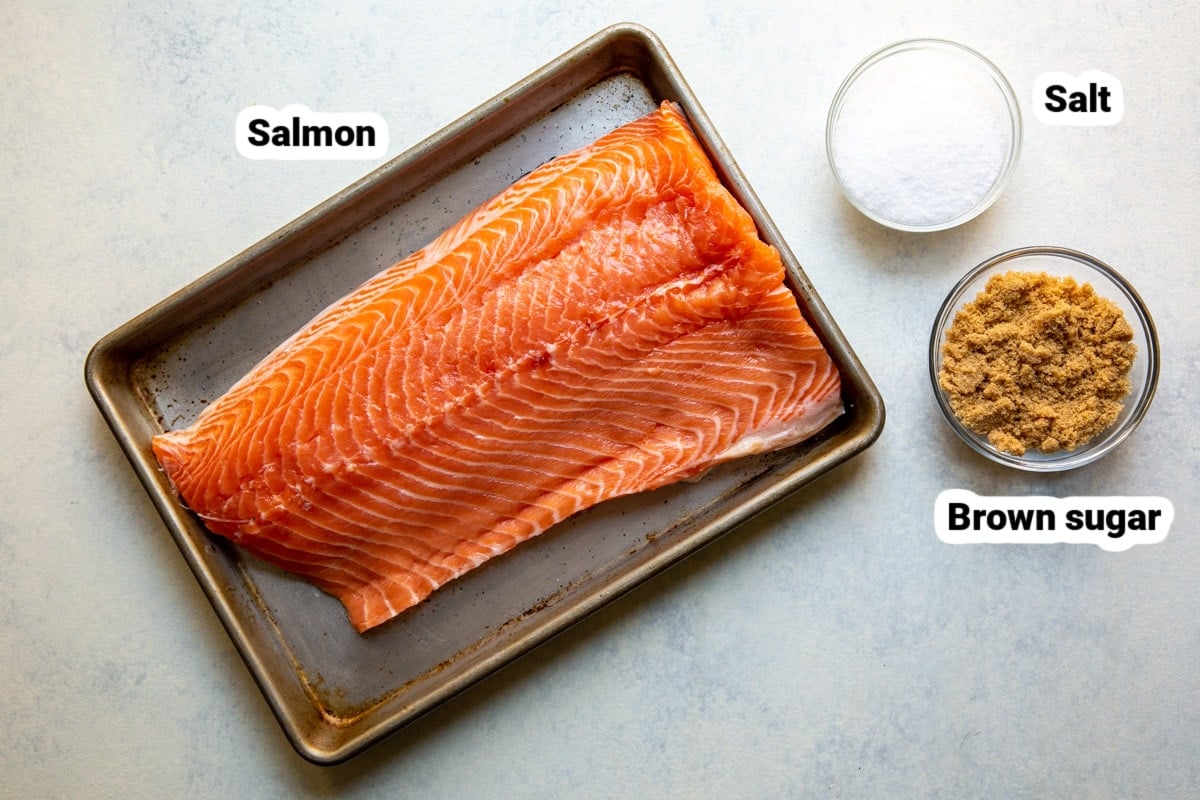
At a Glance: Here is a quick snapshot of what ingredients are in this recipe.
Please see the recipe card below for specific quantities.
Ingredient notes
- Salmon: Any salmon will work with this technique: wild salmon, Steelhead, trout, sockeye, or coho. You can also smoke farmed or wild, line-caught salmon. It’s entirely up to you; just seek out skin-on of whatever variety of salmon you choose, if possible.
- Brown Sugar: Light brown sugar makes a delightful dry brine when mixed with the salt.
- Salt: Kosher salt, such as Morton or Diamond Crystal, is what you’ll want for homemade Smoked Salmon. Ordinary table salt will not work, because it has anti-caking agents in it that will impact the salmon’s flavor. It also measures slightly differently than kosher salt, and my recipe is tailored to the latter.
Step-by-step instructions
- In a large, flat non-reactive glass or plastic dish, add salmon filet. In a small bowl, whisk together the brown sugar and salt. Rub generously over both sides of the salmon. Cover the salmon with plastic wrap and refrigerate for 24 hours.
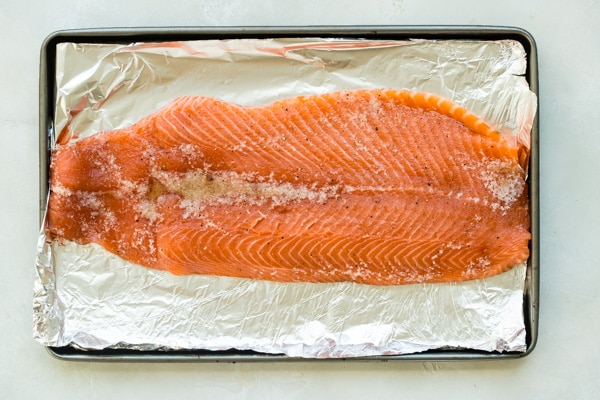
- Rinse salmon thoroughly under cold water to remove the sugar and salt mixture. Lay salmon on paper towels and pat dry on both sides. Transfer the fish to a baking rack set over a clean rimmed baking sheet, skin side down, and let it sit at room temperature for 2 to 4 hours to dry. Once the salmon feels firm and has developed a smooth, shiny skin (called a pellicle), return to the refrigerator until you’re ready to smoke.
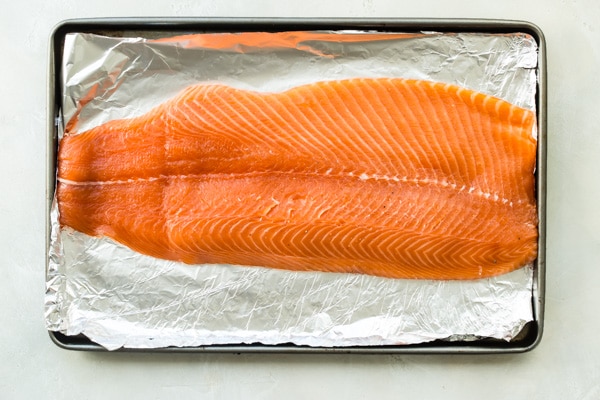
- To smoke the salmon, preheat smoker to 150 degrees. Place salmon directly on the grate. Smoke the salmon until it is firm and tender and reaches 145 degrees, about three hours, keeping the temperature very low, around 130 to 150 degrees.
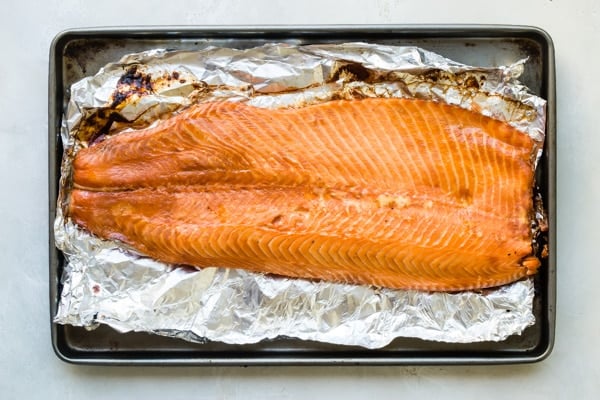
Recipe tips and variations
- Yield: This recipe makes 12 (4-ounce) servings of Smoked Salmon.
- Storage: Store covered in the refrigerator for up to 1 week.
- Freezer: Freeze smoked salmon for up to 2 months. Wrap it tightly in plastic wrap, label, and date. Thaw overnight in the refrigerator. If you see any flaky, dry edges from air exposure, trim them off with a sharp knife.
- Smoked salmon vs. Gravlax vs Lox: Smoked salmon is cured in a salt and/or sugar mixture, then smoked (and it can come from any part of the salmon). Gravlax is cured in salt-sugar-dill mixture and NOT smoked. Lox is cured in a salt mixture and NOT smoked (and it must come from the belly of the salmon).
- How to use Smoked Salmon: Try this completed recipe flaked over salad or pasta, folded into creamy dips (it would be stellar in Easy Dill Dip!), stacked atop a cream cheese-covered Bagel, tucked inside an Omelet, or as an unexpected and amazing substitute for Canadian bacon in Eggs Benedict (aka “Eggs Royal”).
- Tools of the trade: A handful of products will ensure the best results. (Culinary Hill may earn money if you buy through these links).
- A smoker. I swear by my Weber Smokey Mountain. It uses regular charcoal or briquettes and wood chips. You can make Smoked Salmon on a Traeger, a kamodo grill such as a Big Green Egg, a pellet smoker, or an electric smoker, as long as you can control the heat and keep things nice and low.
- Wood chips. Adding hardwood chips boosts the flavor of smoked meat. Play around with a variety pack of wood chips to determine your favorite infusion. Mesquite, pecan, apple, hickory, or cherry all work well.
- A coal chimney. Chimney fire-starters chimney fire-starters are indispensable for grilling and smoking, as they can light coal perfectly, every time, without lighter fluid. All you need is a match and a couple sheets of newspaper.
- An instant-read probe thermometer. I adore my Thermapen.
- A cooling rack. A cooling rack will help dry the fish before smoking, and is also useful for cooling the fish once it comes out of the smoker.
- Plastic or glass container. Those big, shallow food storage containers handle the task beautifully because they fit in the fridge easily and can be stacked on top of each other. You can use a shallow glass baking dish, too.
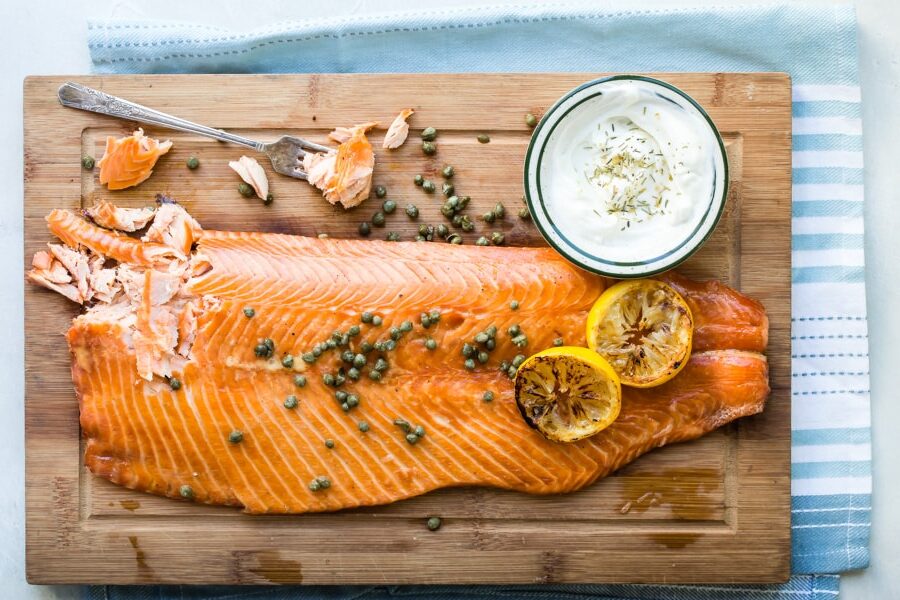
More smoker creations
Grilling and Smoker Recipes
Smoked Chicken Breast
Grilling and Smoker Recipes
Smoked Turkey
Grilling and Smoker Recipes
Smoked Tri-Tip
Appetizer Recipes
Smoked Chicken Wings
Join Us
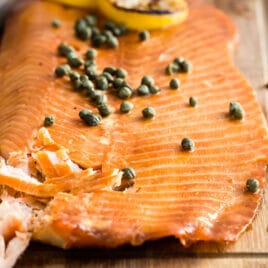
Smoked Salmon
Ingredients
- 3 pound salmon filet about 1 1/2-inch thick, skin on
- 1 cup brown sugar
- 3/4 cup kosher salt
Instructions
- In a large, flat non-reactive glass or plastic dish, add salmon filet. In a small bowl, whisk together the brown sugar and salt. Rub generously over both sides of the salmon. Cover the salmon with plastic wrap and refrigerate for 24 hours.
- Rinse salmon thoroughly under cold water to remove the sugar and salt mixture. Lay salmon on paper towels and pat dry on both sides.
- Transfer the fish to a baking rack set over a clean rimmed baking sheet, skin side down, and let it sit at room temperature for 2 to 4 hours to dry. Once the salmon feels firm and has developed a smooth, shiny skin (called a pellicle), return to the refrigerator until you're ready to smoke.
- To smoke the salmon, preheat smoker to 150 degrees. Place salmon directly on the grate skin-side down. Smoke the salmon until it is firm and tender and reaches 145 degrees, about three hours, keeping the temperature very low, around 130 to 150 degrees.
Notes
- Salmon: Any salmon will work with this technique: wild salmon, Steelhead, trout, sockeye, or coho. You can also smoke farmed or wild, line-caught salmon. It’s entirely up to you; just seek out skin-on of whatever variety of salmon you choose, if possible.
- Brown Sugar: Light brown sugar makes a delightful dry brine when mixed with the salt.
- Salt: Kosher salt, such as Morton or Diamond Crystal, is what you’ll want for homemade Smoked Salmon. Ordinary table salt will not work, because it has anti-caking agents in it that will impact the salmon’s flavor. It also measures slightly differently than kosher salt, and my recipe is tailored to the latter.
- Yield: This recipe makes 12 (4-ounce) servings of Smoked Salmon.
- Storage: Store covered in the refrigerator for up to 1 week.
- Freezer: Freeze smoked salmon for up to 2 months. Wrap it tightly in plastic wrap, label, and date. Thaw overnight in the refrigerator. If you see any flaky, dry edges from air exposure, trim them off with a sharp knife.
- Smoked salmon vs. Gravlax vs Lox: Smoked salmon is cured in a salt and/or sugar mixture, then smoked (and it can come from any part of the salmon). Gravlax is cured in salt-sugar-dill mixture and NOT smoked. Lox is cured in a salt mixture and NOT smoked (and it must come from the belly of the salmon).
- How to use Smoked Salmon: Try this completed recipe flaked over salad or pasta, folded into creamy dips (it would be stellar in Easy Dill Dip!), stacked atop a cream cheese-covered Bagel, tucked inside an Omelet, or as an unexpected and amazing substitute for Canadian bacon in Eggs Benedict (Eggs royal).
- Tools of the trade: A handful of products will ensure the best results. (Culinary Hill may earn money if you buy through these links).
- A smoker. I swear by my Weber Smokey Mountain. It uses regular charcoal or briquettes and wood chips. You can make Smoked Salmon on a Traeger, a kamodo grill such as a Big Green Egg, a pellet smoker, or an electric smoker, as long as you can control the heat and keep things nice and low.
- Wood chips. Adding hardwood chips boosts the flavor of smoked meat. Play around with this variety pack of wood chips to determine your favorite infusion. Mesquite, pecan, apple, hickory, or cherry all work well.
- A coal chimney. Chimney fire-starters chimney fire-starters are indispensable for grilling and smoking, as they can lights coal perfectly, every time, without lighter fluid. All you need is a match and a couple sheets of newspaper.
- An instant read probe thermometer. I adore my Thermapen.
- A cooling rack. A cooling rack will help dry the fish before smoking, and is also useful for cooling the fish once it comes out of the smoker.
- Plastic or glass container. Those big, shallow food storage containers handle the task beautifully because they fit in the fridge easily and can be stacked on top of each other. You can use a shallow glass baking dish, too.
Nutrition
Meggan Hill is a classically-trained chef and professional writer. Her meticulously-tested recipes and detailed tutorials bring confidence and success to home cooks everywhere. Meggan has been featured on NPR, HuffPost, FoxNews, LA Times, and more.
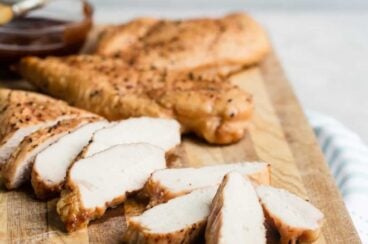
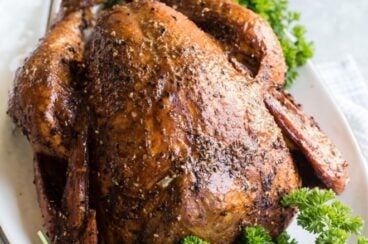
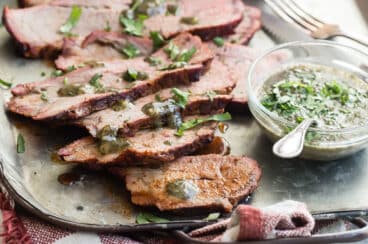
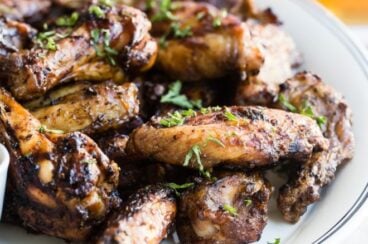
I’ve used this recipe in the past and loved it! Am I imagining things or did there used to be a detailed description of lighting and cooking with the Weber Smokey Mountain for this recipe? I used it a couple times in the past and now I can’t find it.
Hi Steve, I’m sorry about that! We changed the recipe and moved all of the smoker instructions to their own post under “How to Use a Charcoal. Smoker.” I also have the old recipe with the instructions here for you to. Sorry again about that! Smoked Salmon – Meggan
This is exactly what I was looking for. Thank you!
What’s the green thing sprinkled over smoked salmon?
Hi Hira, they are capers. – Meggan
I used this recipe for my first-ever hot smoke and it was great! I used to live in the PNW and spend weeks perfecting the cold smoke. Not that I live inland and have to order my salmon online, I just don’t have the time or energy for it anymore. A hot smoke is such a great compromise. Thanks for sharing!